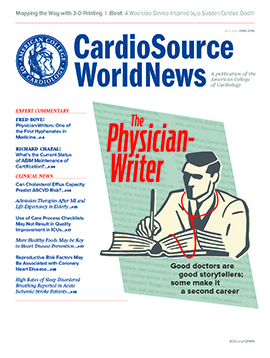Health Tech: Beating the Clock with iBeat, New Wearable Device Inspired by a Personal Loss for Its Creator | Shiv Gaglani
Ryan Howard is a serial entrepreneur who is most well-known for founding Practice Fusion (previously covered in the January 2015 issue of CSWN), a free web-based electronic health record that has reached more than 100,000 physicians. After vacating the CEO position at Practice Fusion, he and a few former colleagues have been busy creating a new wearable device called iBeat.
How did you come up with the idea for iBeat?
In late 2015, a very close childhood friend of mine, Marc Duntley, unexpectedly passed away in his sleep. He was only 40 years old. After Marc passed, I kept thinking, this could’ve been prevented. He could’ve been saved, and that’s what ultimately inspired me to create iBeat. It’s a device that perpetually monitors your heart activity and can get you immediate care in the event of a life-threatening emergency.
How does iBeat work?
iBeat is a life-saving smart watch. We’re coining it a Wearable-as-a-Service™ and targeting an older demographic (50+), as well as people who have heart conditions, for the device.
The device has micro sensors on the underside of the watch face that measure one’s heart rate for irregularities. There is also a built in 3G cellular radio, microphone, and GPS. When/if a cardiac incident is detected, such as the heart slowing or stopping, the user is instantly prompted by watch vibration and a sound alert. If the user is not okay, or if there is no response, the iBeat dispatch team is alerted, and emergency responders are notified with the user’s location and type of emergency.
In tandem, the watch can also notify people nearby and tell them to start giving this person CPR (if they are incapacitated). Emergency contacts and loved ones can also receive a text with a link showing a real-time view of dispatch entries about the user’s status as well as a real-time view of the user’s location.
What stage of development is the product in?
We are currently finalizing our industrial design, and working to bring our prototype into the testing phase for September. We’ve partnered with Ammunition Group, led by Apple’s ex-Head of Industrial Design, Robert Bruner (Jonathan Ive’s predecessor), who built the iBeats headphones and the new Polaroid Instacam. The go-to-market version will include refinement and incorporation of the iBeat brand, as well as color choices for the band, and additional novel tech built into it.
What should cardiologists and other clinicians know about iBeat?
Cardiac arrest is the leading cause of death in the United States, killing nearly 326,000 people a year. Nine out of ten people who have a cardiac arrest incident without intervention die. In fact, the number of people who die each year from cardiac arrest is roughly equivalent to the number who die from Alzheimer’s disease, assault with firearms, breast cancer, cervical cancer, colorectal cancer, diabetes, HIV, house fires, motor vehicle accidents, prostate cancer, and suicides combined. iBeat’s mission is to empower people with the freedom to be fearless, explore, and love longer lives, by helping them to live their lives without the concerns that they will not be able to get help in the case of an emergency. Additionally, by quickening care delivery, we truly believe the iBeat smart watch can prevent fatal heart incidents. No other smart watch or heart-rate tracking monitor currently does this.
Can you discuss any similar products and why this is different?
The iBeat Life Monitor is different from the latest offerings of Fitbit, Life Alert, Apple Watch, or Philips Lifeline. Unlike other personal emergency devices on the market, the iBeat Life Monitor is cellular-enabled and GPS-equipped providing full mobility and remote monitoring. It also syndicates data to users and their contacts, including weekly status updates of their daily heart health, stress, and activity.
In addition to tracking one’s day-to-day activity, iBeat’s sensors can instantly detect cardiac arrest (a sudden, sometimes temporary, cessation of heart function), the signs of arrhythmia (an irregular heartbeat), or atrial fibrillation (an irregular, often rapid heart rate that can cause poor blood flow and lead to stroke). The device is also cellular-enabled allowing it to connect with iBeat’s dispatch center in the case of a life-threatening emergency and send emergency responders, helping quicken care delivery and potentially saving the user’s life. Also, a user’s spouse, family or loved ones can login to a health-tracking dashboard at track their loved one’s heart health and make sure he or she is okay.
How has your background as the founder of Practice Fusion influenced iBeat, if at all?
I spent the past decade building the largest cloud-based electronic health record platform helping connect doctors, patients, and data to drive better health and save lives. I’m applying many things I’ve learned (including incorporating the DNA that established our award-winning culture and product) as well as reconciling some of the mistakes I made at Practice Fusion. I believe in building technology that will be massively impactful to the community. Like Practice Fusion, iBeat will also have the potential to save lives, but in a more personal manner–by speeding the delivery of care.
Shiv Gaglani is an MD/MBA candidate at the Johns Hopkins School of Medicine and Harvard Business School. He writes about trends in medicine and technology and has had his work published in Medgadget, The Atlantic, and Emergency Physicians Monthly.

|
Read the full June issue of CardioSource WorldNews at ACC.org/CSWN |
Keywords: CardioSource WorldNews, Heart Rate, Commerce, Heart Arrest
< Back to Listings
